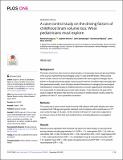| dc.description.abstract | Background
The brain volume loss also known as brain atrophy is increasingly observed among children in the course of performing neuroimaging using CT scan and MRI brains. While severe forms of brain volume loss are frequently associated with neurocognitive changes due to effects on thought processing speed, reasoning and memory of children that eventually alter their general personality, most clinicians embark themselves in managing the neurological manifestations of brain atrophy in childhood and less is known regarding the offending factors responsible for developing pre-senile brain atrophy. It was therefore the goal of this study to explore the factors that drive the occurrence of childhood brain volume under the guidance of brain CT scan quantitative evaluation.
Methods
This study was a case-control study involving 168 subjects with brain atrophy who were compared with 168 age and gender matched control subjects with normal brains on CT scan under the age of 18 years. All the children with brain CT scan were subjected to an intense review of their birth and medical history including laboratory investigation reports.
Results
Results showed significant and influential risk factors for brain atrophy in varying trends among children including age between 14-17(OR = 1.1), male gender (OR = 1.9), birth outside facility (OR = 0.99), immaturity (OR = 1.04), malnutrition (OR = 0.97), head trauma (OR = 1.02), maternal alcoholism (OR = 1.0), antiepileptic drugs & convulsive disorders (OR = 1.0), radiation injury (OR = 1.06), space occupying lesions and ICP (OR = 1.01) and birth injury/asphyxia (OR = 1.02).
Conclusions
Pathological reduction of brain volume in childhood exhibits a steady trend with the increase in pediatric age, with space occupying lesions & intracranial pressure being the most profound causes of brain atrophy. | en_US |

